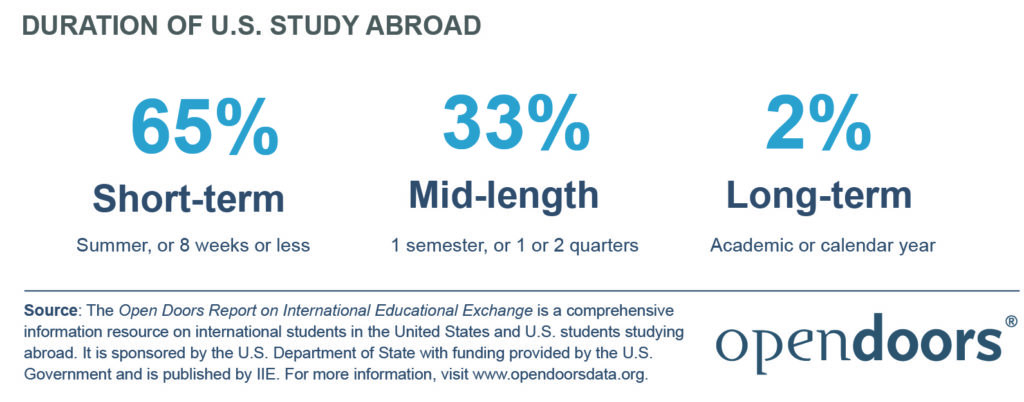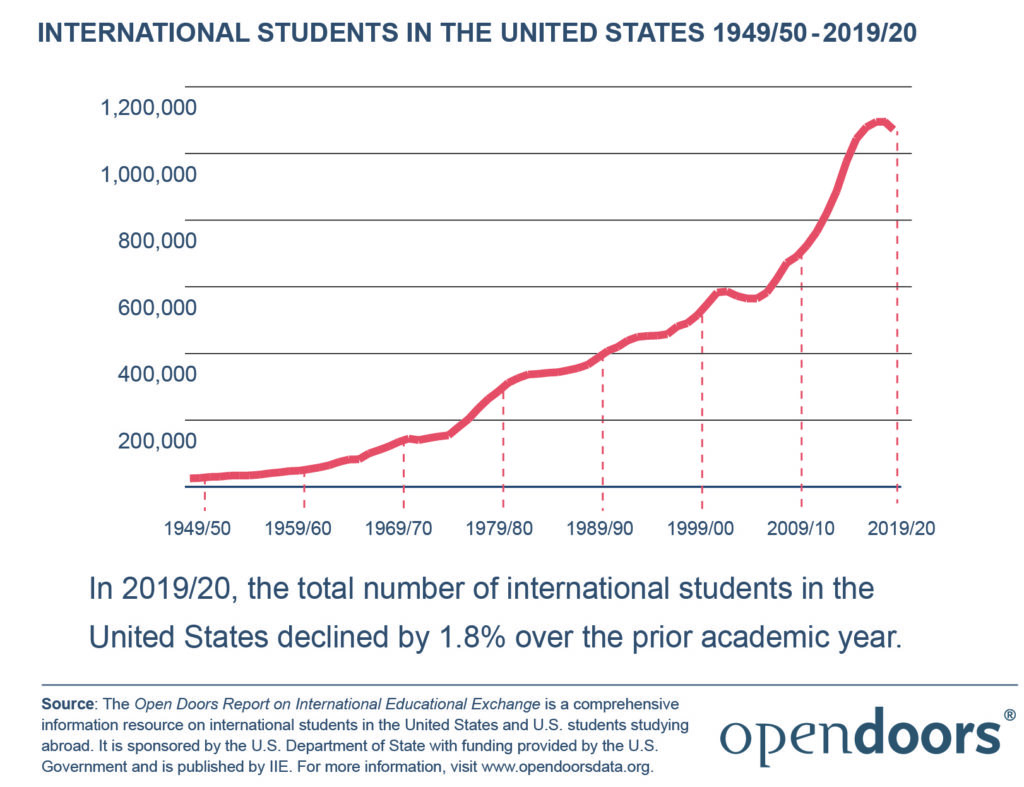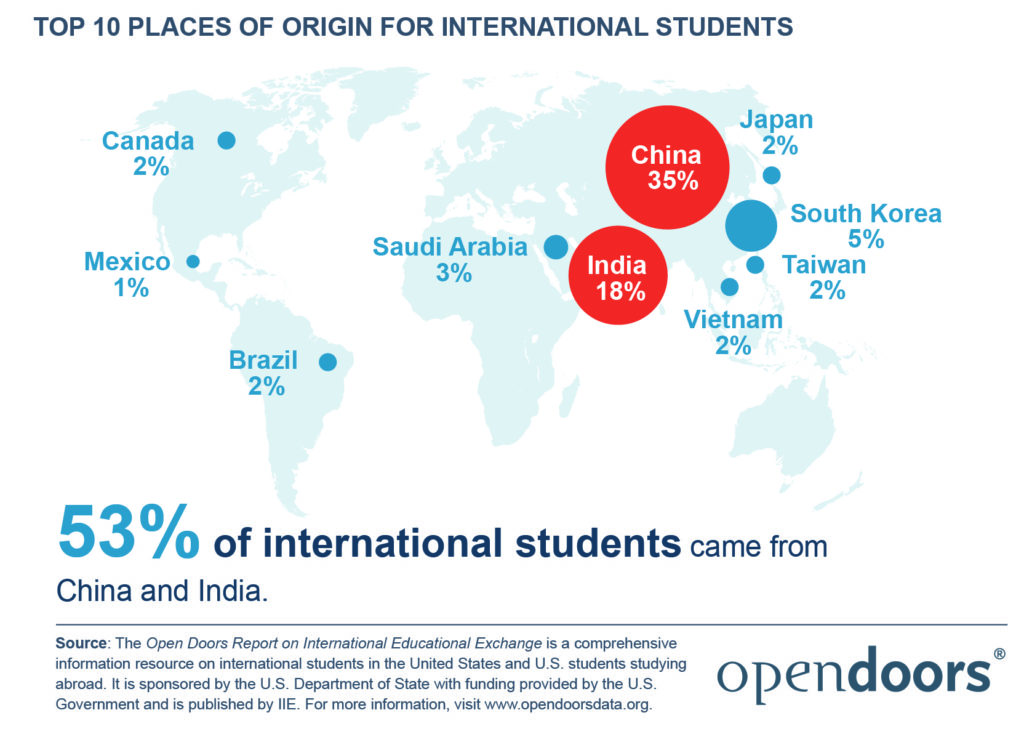
🌟 Embracing a New Chapter: Our Transformation to SSA Education Abroad
A New Era Unveiled Dear Esteemed Educators and Partners, In the spirit of renewal and progress, we’ve taken a monumental step forward. We’re thrilled to

This article is meant to give you an overview of what conclusions can be drawn from all current study abroad data, both U.S. and international students.
For this article we’ve aggregated data from all available study-abroad research that has been conducted.
We will also consider whether studying abroad can help make you a more in-demand employee – based on the research.
Although the connection between study abroad and career success is challenging to prove, we have added data linking what employers desire in new hires and the personal growth that study abroad participants show.
Influence of COVID-19: Keep in mind that the global COVID-19 pandemic has had an inevitable negative impact on study abroad numbers everywhere. Some of the data that we cite in this article is sourced from 2018-19 datasets, given its reliability. However, that’s not to discount the possibility of a more permanent change in the sector, which will be more evident in the next few years.
U.S. Students Studying Abroad from 2014-2019.
Source: Open Doors Report on International Education Exchange
U.S. Students Studying Abroad from 2014-2019.
Source: Open Doors Report on International Education Exchange
It is surprising to note that there is not much variance in the top destinations over the last five or even ten years. The same ten countries have made up the “Top 10 destinations” for the last five years, albeit in slightly different orders.
There is a clear “Big 3” for U.S. students that each represent around 10% of all students studying abroad — United Kingdom, Italy, and Spain and they’ve stayed in those top 3 slots over the last ten decades.
American students consider these destinations of historical and cultural significance – particularly The U.K., thanks to its cultural ties with the U.S., while Italy is a popular destination for students studying, History, Art and Design.
Spain has grown over the last decade to more than 30,000 US students per year. Like Italy, it is a popular destination due to its history, culture, and art. The importance of the Spanish language in the USA and surrounding region is also an essential factor.
Three of the top 10 countries – the United Kingdom, Ireland, and Australia – represented over 61,000 students’ destinations in 2018-2019.
This is not surprising as their university sector teaches in English, mostly removing language barriers from the path of students’ success.
The only Asian country to make the Top 10 is China, popular for business studies as students seek to understand one of the world’s largest economies.
China has had the most significant fluctuation in numbers from year-to-year over the last ten years, but it has stayed relatively consistent between 11,000 and 12.000 in the latest 5-year period.
The only destination in the Americas in the Top 10 is Costa Rica. This Central American country has been politically stable, and its topography and tropical ecosystems provide exciting learning opportunities. Besides, it is an inexpensive place to study the Spanish language.
Here is a look at the recent student numbers for Americans attending study abroad programs in the top destination countries in for-credit programs.
Study abroad was once seen as a time in a student’s (usually a well-heeled student’s) undergraduate years. The famous European cultural and political capitals were usually the key destinations. How much has that changed? Well, some, but certainly not entirely.
Europe, including the United Kingdom, still accounts for more than half of all U.S. student mobility. However, programs have spread out from just the most famous cities to offer various destinations.
The table above shows that Europe still dominates, and while its total “market share” dipped from 60% to 55% over a decade, its real numbers grew. Asia and “multiple destinations” (such as “year at sea” programs) each took a couple of percentage points from Europe, but the “old world’s” draw remains powerful to U.S. students.
Latin American and Caribbean percentages remain almost unchanged; however, students’ regional choice of destination shifts due to new program offerings and political realities.
One of the draws of Europe happens to be the ease of travel between countries. Already famous for its rail system and compact geography, the growth of low-cost airlines such as Ryanair has fueled a new kind of student abroad student who uses a semester program to visit multiple countries on weekends during a semester.
We confess that Spain is of particular interest to us and probably to our readers. With great Southern cities for programs such as Seville and Alicante and the cosmopolitan Barcelona, it is not surprising that Spain has remained in the “Big 3” of destinations for U.S. students, with around 10% of the total.
But the trend from 2008-2009 until 2018-2019 showed steady growth:
Discussions with our students regarding why they choose Spain tend to revolve around the country’s lifestyle and the importance of Spanish.
IIE’s “Open Doors” is a great resource to answer this question. First, keep in mind that the data in “Open Doors” is usually a couple of years old and that the COVID-19 pandemic does not represent a “typical” time, and this will be reflected in future “Open Doors” figures.
Sometimes people point to this number to show that Americans are not very worldly.
However, given the expense of a semester abroad and the need to earn course credits, it can be considered a positive.
To support this, Loncharich, Moose and Vernon reported that 63% of freshmen at college were interested in studying abroad, however only 14.3% ended up achieving to.
Plus, as you’ll see below, the total numbers grew for nine consecutive years, so simply using these statistics to infer a lack of internationalization in U.S. academia is simplistic.
Even with the growth in total numbers over a decade, one demographic has remained relatively steady. About 2 out of every 3 participants in U.S. study abroad programs is female – the annual figure has fallen between 64.7% and 67,3% in each of the last 17 years for which data are available.
There has even been growth in the females to males ratio over the previous several years. It is important to note that U.S. higher education has a higher proportion of females, but the difference is not as stark as the study abroad demographics.
The image of study abroad going back for decades has been that its participants are from well-off, white families. Much research has supported those general impressions; however, the last decade shows a growing diversity pattern. That growth has not been fast, but the trend is clear.
The latest data are reflective of the figures over the last decade. The classic timing is to do a study abroad semester in one’s junior (3rd) year of university. Along with study abroad in a senior (4th) year, this remains the most common time to go. The table below specifies what research demonstrates on the timing of a student’s time abroad.

Some trends are apparent such as the growth of total participants. It does not mean that all of them are doing an entire semester abroad. The opposite is true, actually – it is clear that shorter programs now take a more significant percentage of the total. 63% of students studied abroad for just 8 weeks or less.
Theories to explain it point to the expense of higher education in the USA in general; the thinking is that an entire semester abroad is often not affordable for many families struggling to pay the high cost of college.
The UNC launched a study of a sample of their students in 2016 to discover their economic backgrounds. The following is the income status of the 128 students studied:
The United States has been the #1 destination for international students for decades, and this was true through the 2018 / 2019 school year. Growth was not linear. Important factors are:
Even things like the price of oil are influential, as it affects the ability of oil states’ – such as Saudi Arabia – to sponsor their citizens through scholarships.
Over the last ten years, the trend has been mostly upward, starting at around 650,00 and ending at approximately 900,000 accepted applicants per year.
The USA has seen mostly steady growth in total numbers of international students since 1950, as this graphic illustrates. Universities like the diversity on campus as well as the financial benefit of having international students.

In the USA, students can often participate in what is called “Optional Practical Training” – legal work – as their right as a student visa holder. These periods can be from 1 to 3 years (recent years, so an increase in the number of months of employment permitted growth for STEM area students in graduate fields).
In fact, 53% of those students specialized in STEM fields (science, technology, engineering and mathematics).
International students are now more aware of this possibility, and universities use success in this area as a recruiting message. These factors have meant growth from 76,031 participants in the 2010 / 2011 school year to over 220,000 a decade later.
Especially in the information technology field, some companies use OPT as a trial period for new employees. If the companies are impressed with a student’s work, they may take the time and expense to sponsor their immigration efforts.
The current trend is that a little more than half come from just two countries: China (primarily undergraduate) and India (mostly graduate level) and the other half from everywhere else. South Korea also represents a significant number, at five percent.

Top 10 Places of Origin for International Students in U.S.
Source: Open Doors Report on International Education Exchange
Top 10 Places of Origin for International Students in U.S.
Source: Open Doors Report on International Education Exchange
There has been no great change in the names that appear over the last 20 years. Once dominated by the north-east, California now has several institutions competing for international students, as well as a few in Texas.
Engineering, Math, and Computer Sciences are the standout fields of study. Math and computer science in particular has seen tremendous growth, from 57,266 students in 2000 to 205,207 in 2020 – a growth of 258%, the real bulk of the growth coming between 2010 and 2020.
Although not quite as remarkable as math and computer science, engineering has jumped from 76,834 students in 2000, to 220,542 in 2020 – a growth of 187%
In the following section, we will look at what academic research has demonstrated about the value of studying abroad. Many international education professionals point to hard-to-calculate benefits such as greater cultural awareness, increased self-confidence, improved independence, and growth in knowledge of one’s own and your host country’s culture.
Several years ago IES conducted a survey of more than 3,400 study abroad students. From their research, the following conclusions can be drawn:
Academics have found clear links in language learning when students are put into an immersion environment, such as studying Spanish in Spain or Latin America.
But what about overall intellectual and academic development? Study Abroad appears to add to success in these areas; this article is not intended for deep analysis, but we can point the reader to academic research to back up some key conclusions.
A University of Minnesota study demonstrated that study abroad improves graduation rates. It was shown through longitudinal research with thousands of data points and across various demographic groups.
Research at community colleges in California demonstrated many positive outcomes related to study abroad. These included better GPAs, higher completion rates of 2-year degrees, and a higher transfer rate to 4-year institutions for Bachelor’s degrees.
The GLOSSARI study in Georgia’s state university system attempted to measure the effect of study abroad on several areas, accounting for various potential variables. The research pointed to positive results in three areas of functional knowledge:
Given that higher education in the USA is so expensive, some may be pleased with the research results on intellectual and academic success. However, does studying abroad help you to get a job and succeed in your career?
It’s a complicated question to answer because employment success has many variables associated with it. First, let’s take a look at a 2014 study that sought to assess the “business needs of employees with international expertise” through surveying companies. Among its findings were the following:
The European Commission also released the following findings as part of its Erasmus Impact Survey:
There is a growing body of evidence to suggest that studying abroad results in greater opportunities for participants:
Student mobility has grown in almost all regions of the globe. The USA has benefited from the knowledge and experiences that its students have overseas.
It also profits from international students who bring billions of dollars in economic benefits and expose American students to new cultures and perspectives.
1) Study abroad leads to an improvement in many soft skills, such as working and interacting with people from a diverse range of cultures.
2) The most popular European destinations for US Students are England, Spain, and Italy.
3) Study abroad helps you to dramatically improve your language skills and communication.
4) Study Abroad continues to grow year on year for US students.
5) As work becomes more global, study abroad takes an increasingly vital role in the preparation of our students.

A New Era Unveiled Dear Esteemed Educators and Partners, In the spirit of renewal and progress, we’ve taken a monumental step forward. We’re thrilled to

In Seville, the reality of being a woman intertwines with a vibrant culture and a commitment to female empowerment, reflecting both the beauty and challenges

The mission of SSA is to promote our students’ in-depth understanding of Spanish-speaking countries through specifically designed and academically rigorous university-level and cultural travel programs.


Experience the Fusion of Cultures in San Juan’s SSA Adventure! 🌴📚🇵🇷

Dive into Authentic Cultural Immersion in the Heart of Argentina! 🇦🇷📚🌆

Navigate Through Panama’s Cultural Diversity with English Studies! 🛤️🌐🇵🇦

Venture into Patagonia’s Wild Beauty with the SSA Environmental Studies Program! 🏞️🔍🇦🇷🇨🇱

INSTITUTIONAL RELATIONS Manager
Beth is your go-to contact for navigating the complex process of study abroad.
She aims to respond to all inquiries within one business day.
Don’t hesitate to drop a message. No question is too small!
Trying to learn more about Study Abroad?
We’re sending you our A-Z study abroad guide, including:
